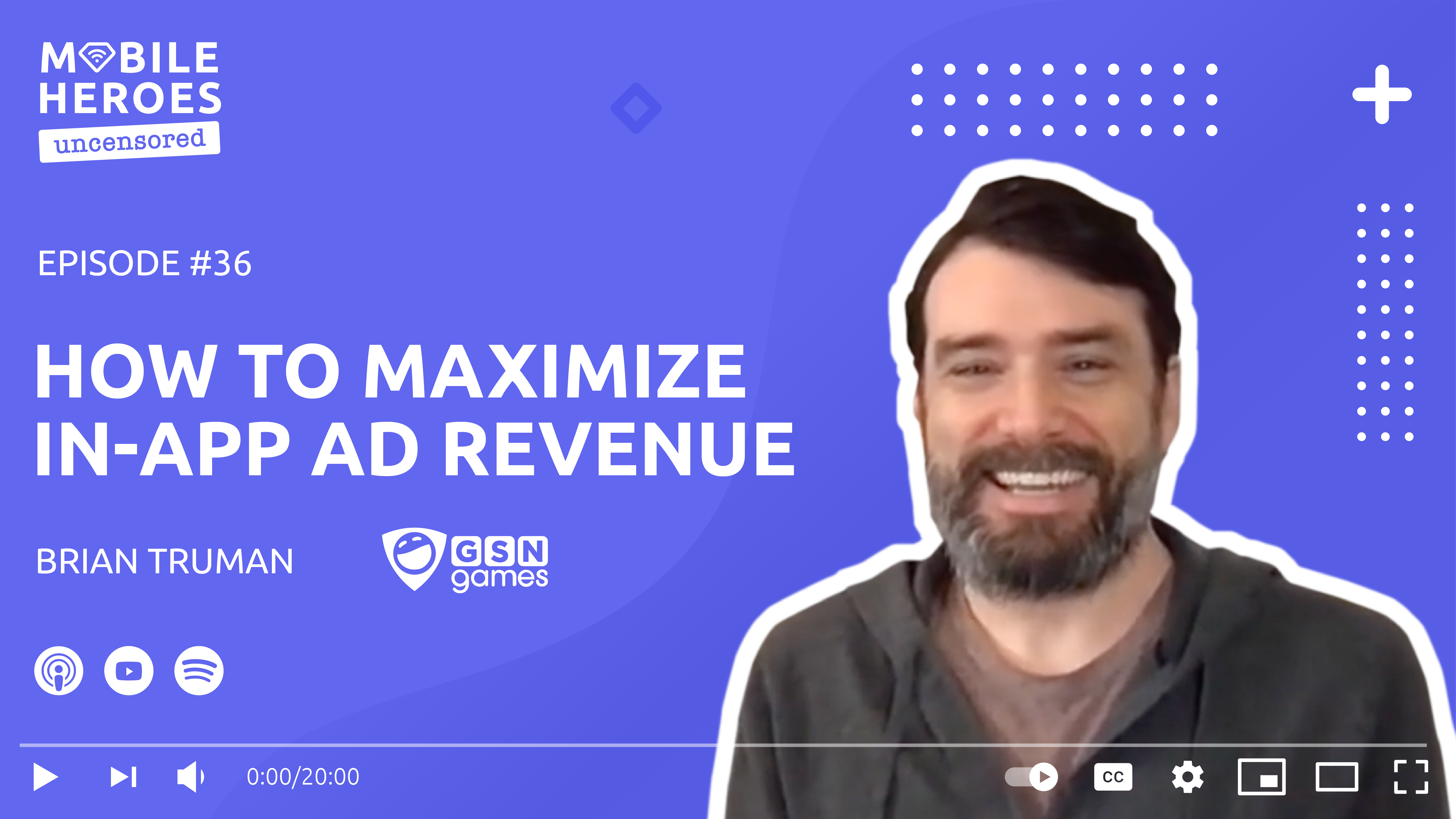Q&A with Brian
This Q&A reflects Brian's time as VP of Ad Revenue & Product at GSN Games. Currently, Brian is Advisor at SPORTPASS and HighRewards.
Brian Truman is VP of Ad Revenue and Product for GSN Games. Before digital marketing, he dabbled in the movie industry. Thanks to his proficiency in Excel keyboard shortcuts, Brian landed a job at a gaming ad network. He now has a decade of experience in digital advertising. He has been entrusted with escalating responsibility and leadership roles and finds satisfaction in mentoring others.
Read Brian's latest article: "How To Future Proof Your Career in Ad Monetization"
In your own words, tell us about the app(s) that you manage?
I have been fortunate enough to work on top mobile games in different categories. I oversee ad revenue and product for the GSN Games portfolio. This includes the casual puzzle solitaire game Solitaire TriPeaks and various social casino games like Bingo Bash.
All the apps predominantly monetize with in-app purchases (IAP), but each one also has an ad monetization strategy. Balancing ads and IAP can be a fun challenge.
How did you get started in mobile monetization?
I was working in the film and TV industry but exploring a career in digital marketing. I had the technical skills to troubleshoot problems and analyze data, which helped me land an entry-level job at a digital ad network focused on user acquisition for free-to-play PC games. During my time there, I worked with top gaming destination sites like Ninja Kiwi, Armor Games, and Kongregate, and with large gaming advertisers including EA, Kabam, and Riot Games. The ad network saw increasing demand for mobile game advertising, and I knew that switching to mobile gaming was a winning career move. Game Show Network later had acquired the ad network, so I had the opportunity to transition from being the general manager of the ad network to lead ad monetization efforts for mobile games developed and published by GSN Games.
If you could start in mobile monetization again, would you do anything differently? What would you do and why?
Two things. I would have acquired more user acquisition or media buying experience. To succeed in ad monetization, you need to understand what the advertiser is optimizing for and how they value the ad inventory. Knowing what drives incremental demand is the key to growing ad revenue. I would also have learned about data science earlier. Advertising operations roles will be automated and simplified increasingly, so subject-matter experts need to expand their data skills to add value.
What do you like most about mobile monetization?
Digital advertising is a marketplace that provides real-time feedback loops. I’m passionate about understanding markets, how they function, and what moves them. When I think about mobile monetization as a market, I’m enthusiastic about two things:
- How to expand the market. Sure, I can grow my market share by increasing the number of ads shown to users, but I want to bring more buyers to the market and increase competition.
- How to be more efficient. Being efficient means reducing waste and maximizing throughput—the rate at which something processes. Cost/benefit analysis is my jam. There’s just nothing better than a well-designed A/B test. Analyzing an A/B test is one of the things I like most.
What do you see as the next big thing in mobile app monetization?
A great deal of money has yet to find its way into mobile apps—gaming specifically. I still hear too much about brand marketers avoiding gaming apps. Consider this—mobile is the only media channel where ad spending is increasing. Games are increasingly accessible and entertaining, and nearly everyone in the US is playing mobile games. I saw one stat suggest that as many as 70% of people in the US play games. The reach of traditional channels is contracting and brand marketers will follow the eyeballs. Bringing these buyers to mobile games is how we expand the market.
Conversely, “easy money” from performance-driven ad campaigns will be harder to come by. For years, app marketers dominated the mobile advertising market because the return on ad spend (ROAS) was improving in a truly remarkable growth environment for free-to-play mobile games. It’s safe to assume this will not always be the case. For this reason and others (privacy regulations, brand advertising), publishers must work harder to turn commodified ad impressions into something special. There will be an increasing need for brand measurement and publishers working with buyers and platforms to utilize first-party data better to inform buying decisions.
How do you balance a positive user experience with the monetization experience in your app(s)?
This is tricky and varies from app to app. But it’s actually the fun part of what I do. Ideally, publishers would think holistically about the game and how ads are designed early in development. But this is an area that requires continuous learning and experimenting. The good thing is that in a digital environment, you can test frequently and receive feedback data quickly. Segmentation and personalization are key here. Unlike ad loads for network television, a digital service can use feedback loops to tailor the experience to several different player types.
In the past year, what is one tip you can share which made the biggest performance difference for your monetization strategy?
We strengthened relationships and improved communication with our ad tech partners. There are three components to ad monetization performance – demand management, supply management, and risk management. In the past year, we faced many challenges from platform changes on iOS, consolidation in the gaming and digital advertising industry, and continuing shifts in the privacy and regulatory environment. Good relationships with our networks and platform partners were vital to managing the risks of these challenges.
What’s a mistake you see get made all the time with mobile monetization strategies, even by smart people and smart companies?
I have seen a failure to measure key long-term metrics. ARPDAU is an important KPI that we often use to measure performance in real-time. But when testing new strategies—especially changes to ad product features—using a predictive LTV model is preferable and more valuable to user acquisition teams. This is the metric that most companies use to optimize their campaign spending. This model is even more critical if you work on an app that balances in-app ads with in-app purchases.
When you advise people on mobile monetization, such as “Do more of this” or “Do less of that,” is there one lesson you share over and over again?
Testing. It is always important to be testing—even re-testing—past assumptions. If a seller’s ABC is “Always Be Closing,” my ABC is “Always Be Checking.” Because behaviors and cohorts change over time, I assume I know nothing and regularly test to validate my monetization strategy for new and existing ad products.
What are your top 3 go-to resources for keeping up with the mobile ad tech industry?
Mobile Dev Memo by Eric Seufert, Ad Exchanger, and many private Slack channels.























